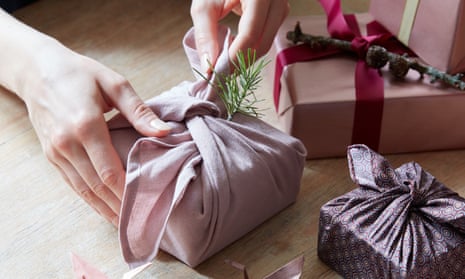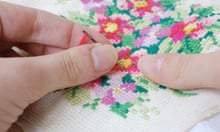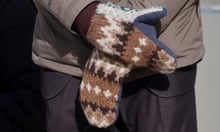Christmas wouldn’t be Christmas without mountains of glittery wrapping paper covering the floor on 25 December. Or would it?
A rise in interest in crafting, coupled with a greater awareness of the environment under lockdown, has led to a surge in interest in furoshiki – the Japanese art of fabric wrapping – this year.
Furoshiki are traditional Japanese cloths used to transport food, clothes or gifts. Both attractive and reusable, they are increasingly being embraced by shoppers as a sustainable alternative to paper.
Over the past three months the website Etsy has seen a 41% year-on-year rise in searches for fabric gift wrap, while searches for eco-friendly wrapping are up by 78%.
Cosmetics retailer Lush sells a wide range of furoshiki-inspired wraps, while they are also available at retailers such as Oliver Bonas and Toast, which this year introduced a set of furoshiki table gifts as an alternative to Christmas crackers. Later this week, John Lewis will host an online furoshiki workshop.
The cloths are easy to use: gifts are placed in the centre of the fabric, which is then tucked around the object and fastened with a knot.
“Because fabric is so much more malleable than wrapping paper, it can be used to make even the most awkward-shaped gifts look professionally wrapped,” says Sarah Carter, founder of Folds, a Bristol-based company that sells reusable organic cotton and certified linen gift wrap. “We usually finish our wrapping by tucking in some dried flowers or a sprig of holly,” she adds.

Folds has always been popular in the festive season, but this year Carter noticed a surge in orders in the spring and summer months. She attributes this to an increase in climate change awareness prompted by Covid-19. “The pandemic has brought the environment into a new focus for people, causing us all to make more environmentally conscious decisions around what we buy.”
Part of the appeal of fabric wrapping is that it is a present in itself. “The receiver can not only enjoy a beautifully wrapped gift but can then reuse the cloth to give a gift of their own,” says Judith Harris, head of house and home at Toast.
Carter says some customers use their cloth within family or friendship circles, so that it eventually makes its way back to them. “There’s a certain magic and tradition in passing it from person to person,” she says.
Then there’s the growing interest in craft. A recent report by the Crafts Council found that our passion for artisan objects is greater than ever. Fabric wrapping is often handmade and it arguably offers more scope for creativity than standard wrapping paper, thanks to the chance to experiment with different folding techniques and the way it lends itself to botanical adornment. “There is a huge appetite for people wanting to learn new craft skills and perhaps create their own gifts for friends and family,” says Harris.
The practice of using furoshiki became widespread during Japan’s Edo period (1603-1868), when people bundled their clothes in fabric while visiting public baths. According to the team at Musubi, a furoshiki specialist with shops in Tokyo and Kyoto, the custom was generally the preserve of older people in Japan, but younger generations are getting on board as a result of the pandemic. “People have started to reconsider their ways of life,” they said.
In addition, the plastic bag charge introduced in Japan in July has encouraged people to transport purchases with the cloths. “Furoshiki has gained attention as a ‘furoshiki-eco bag’ because of that.”
Alternative green gifting ideas include swapping real ribbons for drawn-on versions and replacing wrapping paper with newspaper. But a fabric wrap should have the most longevity – as long as you remember to explain the concept to the recipient.








